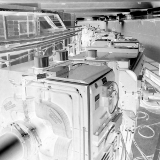Speaker
Joseph Mc Kenna
(TRIUMF (CA))
Description
The aim of the ALPHA experiment at CERN is to trap cold atomic antihydrogen, study its properties, and ultimately to perform precision comparison between the hydrogen and antihydrogen atomic spectra. Recently the collaboration has reached several important milestones. Firstly, demonstrating the ability to trap and confine neutral cold antihydrogen [1][2]; secondly, performing the first spectroscopic measurements of antihydrogen [3]; and of late, through demonstrations of the first application of a new technique, to set limits on the possible anomalous gravitational mass of antihydrogen [4].
The principle tool for antihydrogen detection in the ALPHA experiment is a Silicon Vertex Detector (SVD), built using 72 double-sided silicon strip hybrid modules and designed to surround the neutral atom trap.
Recently upgraded [6], the SVD is used to image single annihilation events, reconstructing spatial and timing data of antiproton annihilation. The detector can be operated in various optimised modes; application modes include low background counting experiments, accurate vertex reconstruction and collective plasma behaviour studies, giving insight into the formation processes of antihydrogen.
A description of the SVD performance, characteristics and an overview of applications in the ALPHA experiment will be given along with a summary of recent results, performance improvements and outlook for probing antihydrogen formation.
Author
Joseph Mc Kenna
(TRIUMF (CA))
